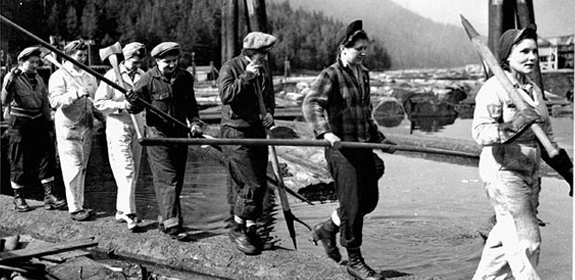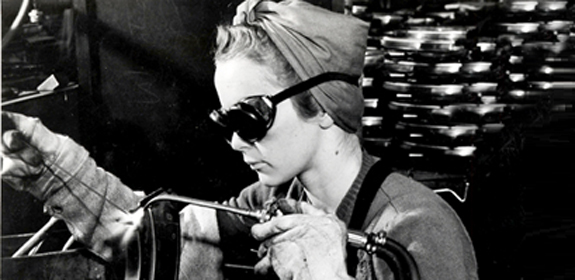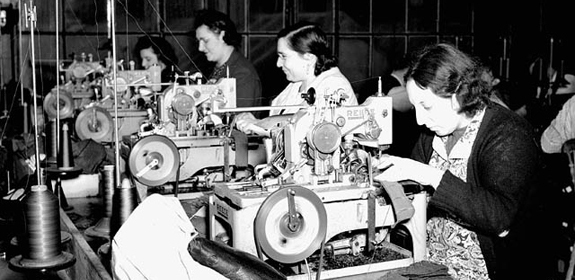Canada Remembers Women on The Home Front
This publication is available upon request in alternate formats.
PDF Version
Canadian women made important contributions on the home front during the war years. They supported our country’s war efforts not only in traditional roles, but also in unprecedented new ways.
In the Home
Home life could be challenging during the war years. “Rationing” was in effect during both the First and Second World Wars, making it hard to obtain sugar, butter, eggs and other scarce food items that were needed to help feed the men fighting overseas. Goods such as rubber, gas, metal and nylon were also difficult to come by because they were needed for the war effort. Women did their part by donating old cookware and other household items to recycling scrap metal drives and encouraging others to “Use it Up, Wear it Out, Make it Do, or Do Without.” This spirit could even be seen in advertisements. “I'm patriotic!” says one woman on a Second World War-era poster as she rolls her hair in tissue rolls instead of curlers, thus saving metal and rubber that could be used to make guns and tires for military vehicles.
It was not easy for women to fill the new roles that arose due to the demands of wartime, while maintaining the traditional female roles of the time. Many women worked tirelessly in the home, often combining their domestic labours with war-related volunteer work with women's organizations or in military canteens.
Women also contributed to the war effort by giving blood and buying war bonds. Many also tended their own gardens (known as Victory Gardens during the Second World War) or volunteered in community gardens so more vegetables and fruits could be grown to feed the local population.
On the Farm
Canadian farms felt their own pressures to meet the growing need for food for the war effort, while also losing many of their young male workers to military service. Many farm women were faced with the reality that they had to maintain the family farm themselves, as well as raise the children, while the husbands, sons and hired labourers were off at war.
Mothers and children worked side-by-side on the farm to ensure it survived and prospered, with responsibilities like planting, harvesting, caring for livestock, milking cows and managing the finances being added to women's normal farm chores. Women adjusted well to this shift in roles and, when the men returned after the war, many women continued helping on the farm in these new ways.
Women's Organizations
The Women's Institutes (WIs) and other women's groups did their part, as well. Helping neighbours was a part of their members' daily lives and, during wartime, their “neighbourhood” expanded to include those in the military. Making quilts, bandages and clothing for the men overseas were just a few of their wartime projects. These groups sent books, newspapers and special treats to military hospitals overseas. They also held “send-off” and “welcome home” parties for servicemen from their area and, after the war, were in the forefront of efforts to create local war memorials. The WIs also had a “Central War Charities Fund” that raised millions of dollars during the Second World War.
The WIs used their agricultural connections to cooperate with the government to establish farm labour bureaus to encourage city women to volunteer to help harvest crops. They also held “canning clubs” to keep up with the high demand for preserved fruits and vegetables. Their members' experiences in adapting recipes to wartime shortages also led them to publish special cookbooks. The average homemaker, struggling to prepare meals within the restrictions of food rationing, found these books to be a great resource.
In Industry
Many men left their civilian jobs to fight for their country during the First and Second World Wars. These jobs needed to be filled and, in the Second World War in particular, women quickly stepped forward to meet the surging demand for workers in a greatly expanding Canadian wartime economy. At the beginning of the war, approximately 570,000 women worked in Canadian industry, mostly at clerical jobs. Five years later, almost a million women would be employed, with many working in traditionally male factory jobs.
Initially, there was a reluctance to allow women into new fields of employment. As the war proceeded, however, it became evident that if the country was to make the most of its resources, women’s contributions would be vital. Many new factories were established to manufacture guns, ammunition, aircraft, ships and more, and women soon could be seen in almost every factory working alongside their male counterparts. This shift in gender roles took some getting used to, but by the end of the war, women had proved to themselves and to the country that they could do any job a man could—and do it well!
After the Second World War ended, incentives for women workers—such as company day care centres—ended and they were encouraged to leave the workforce. Many did stay on to work in the growing service industry, however. The war years had changed the face of Canada’s workplaces forever.
Canada's Own “Rosie the Riveter”
America may have made the fictional “Rosie the Riveter” famous during the Second World War, but Canada found its own female role model in a real person. Elsie MacGill was the first woman to receive an electrical engineering degree in Canada and the first female aircraft designer in the world. The 35-year-old aeronautical engineer supervised the production of Hawker Hurricane fighter planes at the Canadian Car and Foundry Company, which employed 200 women and produced more than 1,450 aircraft during the war. MacGill became a symbol of Canada's miraculous economic wartime transformation. She was even the subject of a comic book called “Queen of the Hurricanes” that was devoted to her achievements.
An Impressive Contribution
Canada's contributions during the war years would have been very different if it were not for the vital roles women played on the home front. The war effort encompassed all Canadians, and women did their fair share and more, achieving and sacrificing a great deal in the cause of peace and freedom. The impressive achievements of these trailblazing women still echo today.
Canada Remembers Program
Women not only contributed to the war effort on the home front; they also played important roles in the military. Learn more about the achievements and sacrifices of Canadian women in uniform by exploring the Canada Remembers Women in the Canadian Military historical sheet.
The Canada Remembers Program of Veterans Affairs Canada encourages all Canadians to learn about the sacrifices and achievements made by those who have served—and continue to serve—during times of war and peace. As well, it invites Canadians to become involved in remembrance activities that will help preserve their legacy for future generations.
- Date modified:


